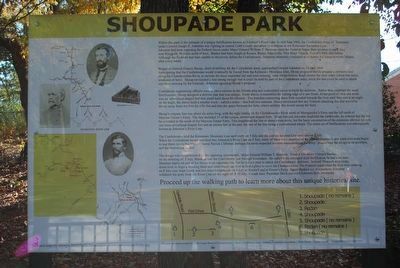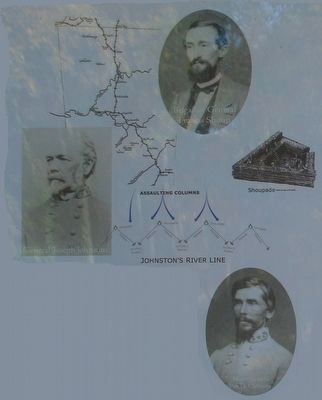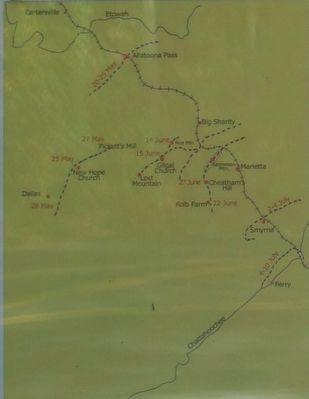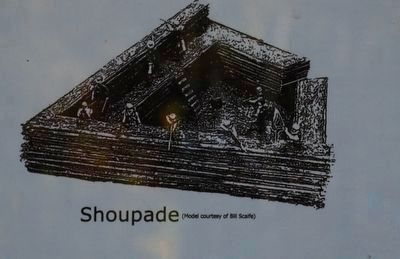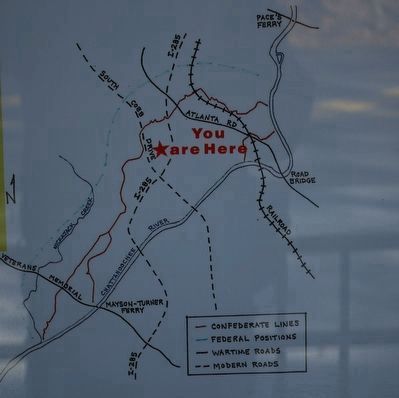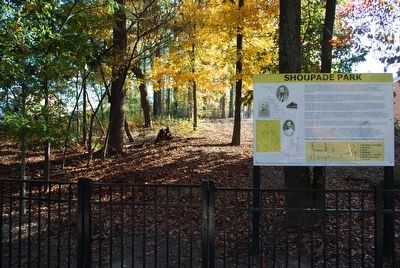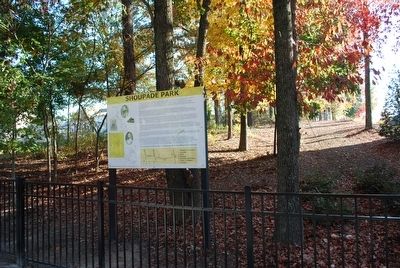Smyrna in Cobb County, Georgia — The American South (South Atlantic)
Shoupade Park
Inscription.
Within this park is the remnant of a unique fortification known as Johnston's River Line. In mid June 1864, the Confederate Army of Tennessee under General Joseph E. Johnston was fighting in central Cobb County and about to withdraw to the Kennesaw Mountain Line. Johnston had been opposing the Federal forces under Major General William T. Sherman since the Federals began their advance in early May near Ringgold, 90 miles north of here. Battles had been fought at Resaca, Rome, Adairsville, New Hope Church, Pickett's Mill, and Dallas: Although the Federals had been unable to decisively defeat the Confederates, Johnston ultimately continued to withdraw his forces towards Atlanta after every battle.
Brigadier General Francis Shoup, chief of artillery for the Confederate army, approached General Johnston on 18 June 1864. Anticipating that the Confederates would eventually be forced from the Kennesaw Mountain Line, Shoup proposed that he prepare a defensive line along the Chattahoochee River, to include the most important rail and road crossing, near where Atlanta Road crosses the river today (about two miles southeast of here). Shoup envisioned a line strong enough that it could be held by part of the Confederate army, while the rest could be used to attack any river crossing by the Federals. Johnston agreed to Shoup's proposal.
Confederate engineering officers went to slave-owners in the Atlanta area and conscripted slaves to build the defenses. Rather than construct the usual fortifications. Shoup designed a defense line that was unique. From above, it resembled the cutting edge of a saw blade. At the point of each saw tooth was an arrowhead-shaped fort that could hold about 80 riflemen. The trenches connecting these forts receded towards the river until they met at an angle. At the angle, the slaves built a smaller work—called a redan—that held two cannons. Shoup envisioned that any Federals attacking this line would be driven away from the forts by rifle fire and into the space between the forts, where artillery fire would sweep the field.
Shoup's original line was about six miles long, with the right resting on the Chattahoochee River north of Montgomery's Ferry and the left north of Mayson-Turner's Ferry. The line included 35 of the unique, arrowhead-shaped forts. When General Johnston inspected the earthworks, he ordered that the left be extended to the south of the Mayson-Turner Ferry. This lengthened the line about seven miles, but the hasty construction of the extension allowed for only one more arrowhead-shaped fort and an anchor fort at the end, the rest of the line being a conventional trench. The entire set of fortifications was subsequently known as Johnston's River Line.
The
Confederates held the Kennesaw Mountain Line until early on 3 July and the interim Smyrna Line until late on 4 July. When the Confederate troops marched into Johnston's River Line on 5 July, many of them were skeptical of the strange structures, and some men even began to tear them down; but Major General Patrick Cleburne, perhaps the most respected division commander in the army, pronounced the design to be excellent, and the destruction ceased.
The design was complimented by the opposing commander, Major General William T. Sherman. From the hill above Vining's Station on the morning of 5 July, Sherman saw the Confederate line through binoculars. He called it the strongest field fortification he had ever seen. Sherman deployed part of this forces in an opposing line, but he did not plan to attack the Confederate defenses. Instead, Sherman sent troops down river to feign a crossing there and other troops up river to find a place to cross the Chattahoochee. The Federals established the first river crossing on 8 July near Sope Creek and two more bridgeheads on 9 July at Roswell and at Power's Ferry. Again flanked out of a position, Johnston withdrew his army from the River Line on the night of 9-10 July. A week later, President Davis removed Johnston from command.
Proceed up the walking path to learn more about this unique historical site.
Text and maps by Georgia Battlefields Association www.georgiabattlefields.org
This park was made possible by Cobb County Board of Commissioners, River Line Historic Area, Oakdale Community Association, Pulte Homes, Easlan Capital, Georgia Battlefields Association
Topics. This historical marker is listed in these topic lists: Forts and Castles • War, US Civil. A significant historical month for this entry is June 1864.
Location. 33° 50.202′ N, 84° 29.539′ W. Marker is in Smyrna, Georgia, in Cobb County. Marker is on Oakdale Road south of Fort Drive, on the left when traveling south. Touch for map. Marker is at or near this postal address: 4770 Oakdale Road, Smyrna GA 30080, United States of America. Touch for directions.
Other nearby markers. At least 8 other markers are within 2 miles of this marker, measured as the crow flies. First Shoupade (within shouting distance of this marker); Artillery Redan (about 400 feet away, measured in a direct line); Second Shoupade (about 500 feet away); Collins Springs Primitive Baptist Church (approx. 0.6 miles away); Here Johnston’s River Line Crossed the Rd. (approx. 1.3 miles away); United Distributors (approx. 1.8 miles away); Whittier Cotton Mill and Village (approx. 1.9 miles away); The Alexander Eaton House: Hood’s H'dq'rs. (approx. 1.9 miles away). Touch for a list and map of all markers in Smyrna.
Credits. This page was last revised on October 20, 2020. It was originally submitted on August 10, 2015, by Brandon Fletcher of Chattanooga, Tennessee. This page has been viewed 598 times since then and 32 times this year. Photos: 1, 2, 3, 4, 5, 6, 7, 8. submitted on August 10, 2015, by Brandon Fletcher of Chattanooga, Tennessee. • Bernard Fisher was the editor who published this page.
